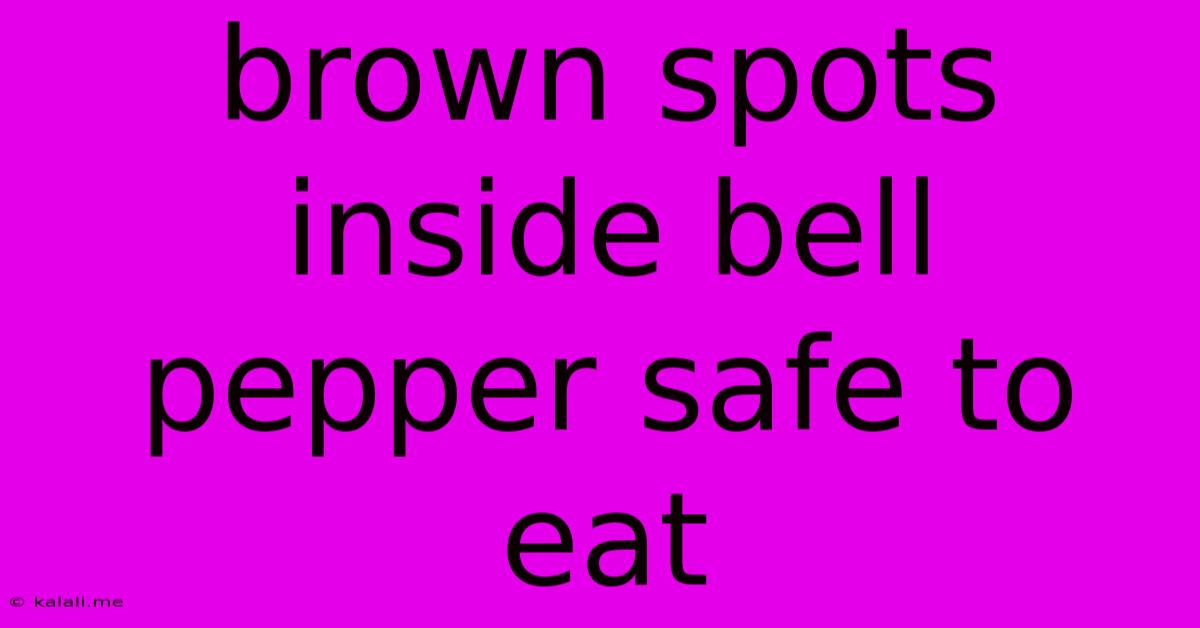Brown Spots Inside Bell Pepper Safe To Eat
Kalali
Jun 01, 2025 · 2 min read

Table of Contents
Brown Spots Inside Bell Peppers: Safe to Eat or Toss?
Finding brown spots inside your vibrant bell pepper can be a bit disconcerting. Are they a sign of spoilage, or is it perfectly fine to still use that pepper in your salsa? This article will help you determine whether those brown spots mean your pepper is safe to eat or should be discarded. We'll explore the causes of these blemishes and provide you with guidance on how to assess their edibility.
What Causes Brown Spots in Bell Peppers?
Brown spots inside bell peppers are often a result of bruising or natural aging. During harvesting, shipping, and handling, peppers can be bumped and bruised, leading to discoloration. This bruising doesn't necessarily indicate bacterial contamination but rather damage to the pepper's internal tissues. As the pepper ages, enzymatic processes can also cause browning, even without physical damage. This is especially common near the stem or core.
Other factors that can cause brown spots include:
- Overripe peppers: As peppers mature beyond their peak ripeness, they can start to develop brown spots as part of their natural aging process.
- Improper storage: Incorrect storage can accelerate spoilage. Storing peppers in the refrigerator for too long can lead to chilling injury and discoloration.
- Disease: In rare cases, brown spots might indicate a fungal or bacterial disease. However, this is less common than bruising or age-related discoloration.
How to Tell if Your Bell Pepper is Still Good:
The key is to assess the extent and nature of the browning.
- Small, isolated brown spots: If you see a few small brown spots and the rest of the pepper looks firm, vibrant, and free of mold or unpleasant odor, it's likely still safe to eat. Simply cut away the affected areas before using the pepper.
- Large, widespread brown areas: If a significant portion of the pepper is brown, mushy, or slimy, it's best to discard it. This indicates advanced spoilage.
- Mold: The presence of any mold—fuzzy, white, green, or black—is a clear sign of spoilage and the pepper should be thrown away.
- Unpleasant odor: A sour or off-putting smell is another warning sign of spoilage.
Tips for Storing Bell Peppers to Prevent Browning:
Proper storage can significantly extend the life of your bell peppers and help prevent browning.
- Refrigerate: Store peppers in the refrigerator's crisper drawer in a plastic bag.
- Don't wash before storing: Washing peppers before storing can accelerate spoilage.
- Use within a week: Even with proper storage, bell peppers are best used within a week of purchase.
In summary: Small, isolated brown spots on bell peppers are usually harmless and can be easily removed. However, if a significant portion of the pepper is brown, mushy, or moldy, it's best to err on the side of caution and discard it. Pay attention to the overall appearance, texture, and smell of your peppers to ensure they are still safe for consumption. Always prioritize food safety.
Latest Posts
Latest Posts
-
Canon A1 Mis Aligned Frame Counters
Jun 02, 2025
-
Best Way To Keep Mice Out Of Your House
Jun 02, 2025
-
Sqlite3 Insert Or Ignore Vs On Conflict
Jun 02, 2025
-
What U Got On My 40
Jun 02, 2025
-
Why Do Names In Gmail Have Gmail Addresses In Parentheses
Jun 02, 2025
Related Post
Thank you for visiting our website which covers about Brown Spots Inside Bell Pepper Safe To Eat . We hope the information provided has been useful to you. Feel free to contact us if you have any questions or need further assistance. See you next time and don't miss to bookmark.